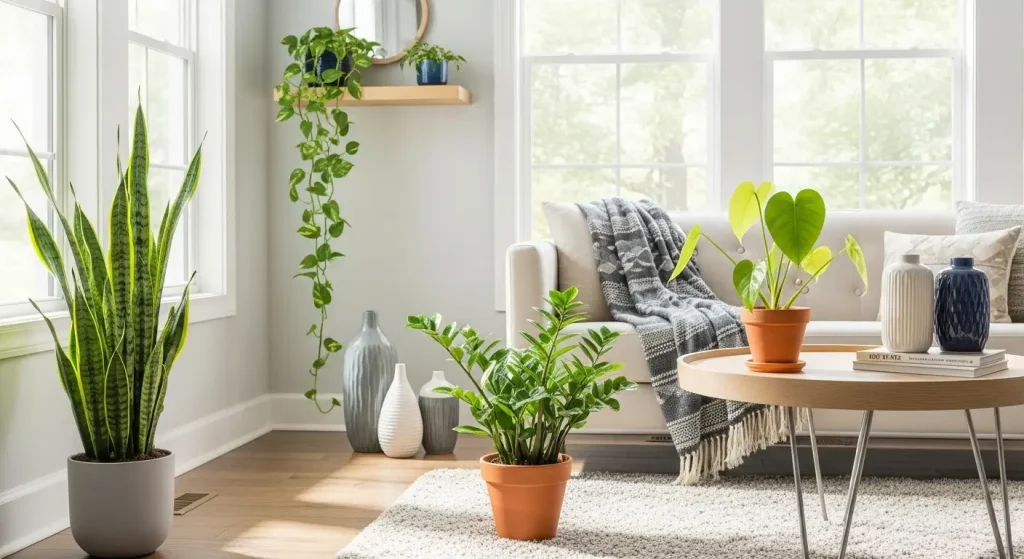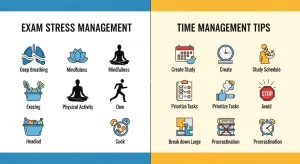Starting your journey with houseplants can feel overwhelming, but creating a thriving indoor garden is easier than you think. Whether you’re a complete beginner or someone who’s struggled to keep plants alive, this comprehensive guide will introduce you to the best indoor plants that practically take care of themselves.
With the right plant selection and basic knowledge, you’ll soon transform your home into a green oasis that not only looks stunning but also improves your air quality and mental well-being.
Budget-Friendly Home Renovation Tips that Last
Why Choose Indoor Plants for Your Home?
Indoor plants offer numerous benefits beyond their aesthetic appeal. Many indoor houseplants such as pothos, philodendron, zz plant and snake plant are easy to grow and very forgiving of inconsistent watering. These green companions help purify your indoor air, reduce stress levels, and add natural beauty to any space.
For beginners, the key is selecting easy care plants that can tolerate various lighting conditions and forgive occasional neglect. The good news? There are plenty of gorgeous options that fit this description perfectly.
Best Houseplants for Beginners
Low Light Indoor Plants That Actually Thrive
Many homes don’t receive abundant natural light, but that doesn’t mean you can’t enjoy beautiful houseplants. These low light plants are perfect for darker rooms, offices, or north-facing windows:
1. Snake Plant (Sansevieria trifasciata)
The snake plant is virtually indestructible and tops every list of beginner houseplants. Its striking vertical leaves tolerate low light conditions and can go weeks without water. Perfect for busy lifestyles!
2. ZZ Plant (Zamioculcas zamiifolia)
Known as one of the most resilient indoor plants, the ZZ plant features glossy, dark green leaves that add elegance to any space. It thrives in low light and requires minimal watering.
3. Pothos (Epipremnum aureum)
Pothos is especially hard to kill and very forgiving of inconsistent watering. This trailing plant is perfect for hanging baskets or shelves and grows well in various light conditions.
4. Philodendron
Similar to pothos, philodendrons are among the most forgiving easy care plants available. Their heart-shaped leaves create beautiful cascading displays.
10 Timeless Fashion Staples Every Wardrobe Needs
Medium to Bright Light Options
If you have windows that receive good natural light, consider these stunning houseplants:
5. Fiddle Leaf Fig (Ficus lyrata)
This trendy indoor plant makes a bold statement with its large, violin-shaped leaves. While it needs bright, indirect light, it’s more manageable than its reputation suggests.
6. Rubber Plant (Ficus elastica)
With glossy, burgundy-tinted leaves, rubber plants add sophistication to any room. They’re forgiving and adapt well to different lighting conditions.
7. Monstera Deliciosa
Easy, hard-to-kill plants like Monstera or Pothos are usually a great starting point. The monstera’s iconic split leaves make it a social media favorite and conversation starter.
Newborn Care 101: Essential Tips for First-Time Parents
Essential Plant Care Tips for Beginners
Watering Your Indoor Plants
The most common mistake beginners make is overwatering their houseplants. Water when the top 1-2 inches of soil are dry, but avoid letting them sit in standing water to prevent root rot. This simple rule applies to most indoor plants and will keep your green friends healthy.
Watering Schedule Guidelines:
- Low light plants: Water every 1-2 weeks
- Medium light plants: Water weekly
- Bright light plants: Water 2-3 times per week
Choosing the Right Soil
Use a well-draining potting mix designed for indoor plants to ensure proper root health. Regular garden soil is too heavy for container growing and can lead to drainage problems.
Understanding Light Requirements
Selecting the best indoor plant with light requirements that match the location can be one of the most important factors in growing a healthy plant. Before purchasing houseplants, assess your home’s lighting conditions:
- Low light: North-facing windows, areas 6+ feet from windows
- Medium light: East or west-facing windows with filtered light
- Bright light: South-facing windows with some protection from direct sun
Creating Your Indoor Plant Collection
Start Small and Build Confidence
We suggest starting with an easy-care plant like a spider plant or pothos to gain confidence before expanding your indoor jungle. Begin with 2-3 beginner houseplants and gradually add more as you develop your plant care routine.
Design Considerations
Group indoor plants with similar care requirements together to make maintenance easier. Consider varying heights and textures to create visual interest while keeping care routines simple.
Essential Travel Tips for First-Time Solo Travelers: Your Complete Guide to Safe and Memorable Adventures
Common Beginner Mistakes to Avoid
- Overwatering: The #1 killer of houseplants
- Wrong light placement: Placing sun-loving plants in dark corners
- Ignoring plant needs: Not researching specific care requirements
- Impulse buying: Choosing plants based on looks rather than your ability to care for them
- Giving up too quickly: Every plant parent learns through experience
FAQ Section
What are the easiest houseplants for absolute beginners?
The easiest houseplants for beginners include snake plants, ZZ plants, pothos, and philodendrons. These low light plants are extremely forgiving and can tolerate irregular watering schedules while still thriving in most indoor plant environments.
How often should I water my indoor plants?
Water frequency depends on the specific houseplants you own, but a general rule is to check the soil weekly. Water when the top 1-2 inches of soil are dry. Most beginner houseplants prefer to dry out slightly between waterings rather than staying consistently moist.
Can houseplants really survive in low light conditions?
Yes! Many indoor plants not only survive but thrive in low light conditions. Low light plants like snake plants, ZZ plants, and pothos have adapted to grow in minimal light, making them perfect easy care plants for darker rooms or offices.
What’s the best potting soil for indoor plants?
Choose a high-quality potting mix specifically designed for indoor plants. These mixes provide proper drainage and aeration that houseplants need to develop healthy root systems. Avoid using garden soil, which can be too heavy for container growing.
How do I know if my houseplant is getting enough light?
Signs your indoor plants need more light include leggy growth, pale leaves, or leaning toward light sources. Low light plants are more tolerant, but if you notice these symptoms, consider moving your houseplants closer to a window or adding a grow light.
Investing 101: A Beginner’s Guide to the Stock Market
Transform Your Home Today
Ready to start your indoor plant journey? Remember, the best houseplants for beginners are those that match your lifestyle and home conditions. Start with proven easy care plants like pothos or snake plants, and gradually expand your collection as your confidence grows.
Don’t let fear hold you back from enjoying the beauty and benefits of indoor plants. With the right selection and basic care knowledge, you’ll soon have a thriving indoor garden that brings joy and natural beauty to your everyday life.
Ready to get started? Check out our recommended collection of beginner-friendly houseplants perfect for your first indoor garden:











